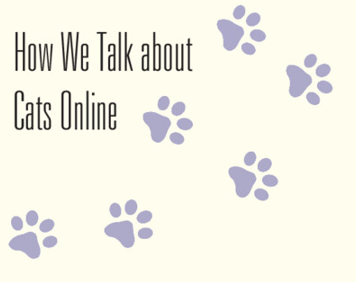
You do not necessarily have to follow online cats on social media to read the book, but if you do, you might have come across one or the other cat-inspired linguistic process before or have perhaps found a meowlogism not mentioned in the book. Yet, regardless of your online habits, a curiousity for all things feline and linguistic is the only thing required.
Our relationship with cats goes back a long time and has had its ups and downs throughout the ages: Humans have revered them as gods, abhorred them as devils, have seen them as guardians, as good luck and bad. A recent tweet shared on Instagram said ‘An ancient Egyptian comes back to life and logs on to twitter: Ah I see the felines are still gods’ (Katelyn Burns, @transscribe, shared by @catconworldwide). I could stop right here and rest my case, but I won’t.
While a view of cats as gods and our overlords is widely shared online, it is just one perspective we can study in online cats. There is more: for example, the human and feline identities we take up online and there is the effect online cats have on our communication behaviour.
Many animals have an online presence, and we can follow dogs, hamsters, hedgehogs, llamas, and, of course, cats. Among the social media accounts featuring animals, we find many accounts that are managed in the name of a specific animal. In the case of our feline friends, these are the cat accounts in the cat-related digital spaces, which are present on all the major social media platforms, like Instagram, Facebook, Twitter, YouTube, TikTok, reddit, and others.
And it is in these online places that we encounter language varieties which we can look at on various linguistic levels. A good example is the analysis at the relationship of language and identity, which is a part of sociolinguistics. In cat-related digital spaces, a common practise is to take on a feline identity and post as the cat itself. Users are giving their cats a voice, and the feline voice has become indexed by purrieties, that is feline-inspired language varieties with various features, such as meowlogisms, LOLspeak, Hambspeak, and other individual cat idiolects.
Purrieties as such are not limited to English but are found in other languages, too. Similar linguistic mechanisms are employed, say, in French, when users produce meowlogisms by inserting French meowphemes into their posts. The word ‘ministre’ becomes ‘minoustre’ with the help of ‘minou’, a French word for ‘cat’. Once we start to look, we will discover more and more such examples.
Not just cat-related digital spaces but also cats in general are a real linguistic treasure trove because we have a largy quantity of material available to study. We can go back in time to the beginnings of dialectology and dictionary making at the turn of the last century and study cat-related entries in terms of phonetics and lexicology, but we can also fast-forward to the 21st century to the digital era and look at how we communicate on the interactive multimodal platforms where we combine text, audio, and video in our messages.
The academic world, too, has been immersed in catsifaction. The digital spaces around ‘academics with cats’ have already spread across social media platforms as well as across various scientific subjects. Cats help us in our research, in our studies, and in our teaching, and, regardless of our academic positions, this is something we enjoy sharing by using the hashtag #AcademicsWithCats.
What are the curious bits and pieces I have come across in my feline-inspired research? There are a few, though strictly speaking they are chosen randomly based on my personal likes and interests.
When I began my research, I was astonished by the sheer number of cat accounts on social media. Even though I was initially drawn to researching online cats by viral cat memes and cat videos, I quickly saw that the main purpose to have a cat account is the possibility to share images of our cats – because we love our cats and we find them beautiful rather than because we want to have a cat celebrity like Maru or Grumpy Cat or to make them into viral memes.
My favourite word for ‘cat’ is ‘the mazger’, which was recorded in the Survey of English Dialects in the 1950s. The origins of this word are unclear, and I was told that ‘mazger’ was a ‘nunce word’ and most probably the name of a particular cat. Diving into already existing surveys and language corpora on the look-out for cats is entertaining, and again I was pleasantly surprised to find so many cat-related entries. That is also true for the hunt for cats in linguistic research: Cats are everywhere.
Other favourite words of mine are connected to black cats, like ‘void’, ‘panther’, and ‘mini-panther’, and their special day on #PantherThursday. These words are used a lot in the digital spaces around black cats. Of course, people have created words for cats of other colours, too, for example the word ‘tortitude’, which refers to the attitude of a tortoiseshell cat.
One question, however, remains unanswered, namely why cats find cardboard boxes so fascinating. I would really love to know the reason for the attraction of cardboard boxes to cats, but researching cats’ love for boxes is not part of a linguistic enquiry.
Latest Comments
Have your say!